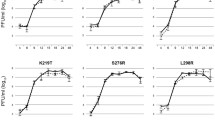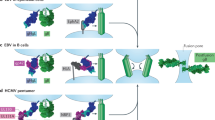Abstract
Feline herpesvirus-1 (FHV-1) causes a severe upper respiratory and ocular disease in cats. An effective antiviral compound is required for treating FHV-1 infections. The virus-encoded thymidine kinase (TK) is the molecular basis for selective activation of commonly used antiviral nucleoside analogue drugs, e.g. acyclovir (ACV), penciclovir (PCV) and ganciclovir (GCV). The substrate specificity of a recombinant FHV-1 TK, expressed in Escherichia coli, was studied. FHV-1 TK efficiently phosphorylated its natural substrate deoxythymidine. However, it exhibited relatively lower affinity for the guanosine analogue substrates. PCV was most efficiently phosphorylated, followed by GCV, with approximately twofold reduction in the phosphorylation rate. The lowest phosphorylation rate was recorded for ACV. To correlate these biochemical data with structural features of the FHV-1 TK, a three-dimensional (3D) model of this enzyme was constructed based on sequence homology with two other herpesviral TKs, encoded by equine herpesvirus-4 (EHV-4) and herpes simplex-1 (HSV-1). Mutational analysis of the amino acids forming the FHV-1 TK active site identified two residues (Y29 and F144) as being critical for the differential ability of this enzyme to phosphorylate nucleoside analogues. A double substitution of Y29H/F144Y resulted in a threefold increase in the ACV phosphorylation rate.







Similar content being viewed by others
References
Alber F, Kuonen O, Scapozza L, Folkers G, Carloni P (1998) Density functional studies on herpes simplex virus type 1 thymidine kinase–substrate interactions: the role of Tyr-172 and Met-128 in thymine fixation. Proteins 31:453–459
Andrew SE (2001) Ocular manifestations of feline herpesvirus. J Feline Med Surg 3:9–16
Baker D, Sali A (2001) Protein structure prediction and structural genomics. Science 294:93–96
Bennett MS, Wien F, Champness JN, Batuwangala T, Rutherford T, Summers WC, Sun H, Wright G, Sanderson MR (1999) Structure to 1.9 A resolution of a complex with herpes simplex virus type-1 thymidine kinase of a novel, non-substrate inhibitor: X-ray crystallographic comparison with binding of aciclovir. FEBS Lett 443:121–125
Blundell TL, Jhoti H, Abell C (2002) High-throughput crystallography for lead discovery in drug design. Nat Rev Drug Discov 1:45–54
Brooks BR, Bruccolesi RE, Olafson BD, States DJ, Swaminathan S, Karplus M (1983) CHARMM: a program for macromolecular energy minimisation and dynamics calculations. J Comput Chem 4:187–217
Brown DG, Visse R, Sandhu G, Davies A, Rizkallah PJ, Melitz C, Summers WC, Sanderson MR (1995) Crystal structures of the thymidine kinase from herpes simplex virus type-1 in complex with deoxythymidine and ganciclovir. Nat Struct Biol 2:876–881
Champness JN, Bennett MS, Wien F, Visse R, Summers WC, Herdewijn P, de Clerq E, Ostrowski T, Jarvest RL, Sanderson MR (1998) Exploring the active site of herpes simplex virus type-1 thymidine kinase by X-ray crystallography of complexes with aciclovir and other ligands. Proteins 32:350–361
Collins P (1983) The spectrum of antiviral activities of acyclovir in vitro and in vivo. J Antimicrob Chemother 12(Suppl B):19–27
Copeland RA (2000) Enzymes: a practical introduction to structure, mechanism and data analysis. 2nd edn. Wiley, New York
Darby G (1994) A history of antiherpes research. Antivir Chem Chemother 5:3–9
De Clercq E, Brancale A, Hodge AV, Field HJ (2006) Antiviral chemistry and chemotherapy’s current antiviral agents FactFile 2006 (1st edition). Antivir Chem Chemother 17:113–166
Earnshaw DL, Bacon TH, Darlison SJ, Edmonds K, Perkins RM, Vere Hodge RA (1992) Mode of antiviral action of penciclovir in MRC-5 cells infected with herpes simplex virus type 1 (HSV-1), HSV-2, and varicella-zoster virus. Antimicrob Agents Chemother 36:2747–2757
Elion GB (1993) Acyclovir: discovery, mechanism of action, and selectivity. J Med Virol (Suppl 1):2–6
Evans JS, Lock KP, Levine BA, Champness JN, Sanderson MR, Summers WC, McLeish PJ, Buchan A (1998) Herpesviral thymidine kinases: laxity and resistance by design. J Gen Virol 79(Pt 9):2083–2092
Fersht A (1999) The basic equations of enzyme kinetics structure and mechanism in protein science: a guide to enzyme catalysis and protein folding. W. H. Freeman and Company, New York, pp 103–129
Fetzer J, Michael M, Bohner T, Hofbauer R, Folkers G (1994) A fast method for obtaining highly pure recombinant herpes simplex virus type 1 thymidine kinase. Protein Expr Purif 5:432–441
Field HJ, Whitley RJ (2005) Antiviral chemotherapy. In: Mahy BWJ, Meulen V (eds) Topley and Wilson’s microbiology and microbial infections, vol 2, 10th edn. Hodder Arnold, London, Virology, pp 1605–1645
Fiser A (2004) Protein structure modeling in the proteomics era. Expert Rev Proteomics 1:97–110
Furman PA, St Clair MH, Spector T (1984) Acyclovir triphosphate is a suicide inactivator of the herpes simplex virus DNA polymerase. J Biol Chem 259:9575–9579
Fyfe JA, McKee SA, Keller PM (1983) Altered thymidine–thymidylate kinases from strains of herpes simplex virus with modified drug sensitivities to acyclovir and (E)-5-(2-bromovinyl)-2′-deoxyuridine. Mol Pharmacol 24:316–323
Galle LE (2004) Antiviral therapy for ocular viral disease. Vet Clin North Am Small Anim Pract 34:639–653
Gardberg A, Shuvalova L, Monnerjahn C, Konrad M, Lavie A (2003) Structural basis for the dual thymidine and thymidylate kinase activity of herpes thymidine kinases. Structure (Camb) 11:1265–1277
Gaskell R, Willoughby K (1999) Herpesviruses of carnivores. Vet Microbiol 69:73–88
Gaskell RM, Dawson S (1994) Chapter 14: Viral-induced upper respiratory tract disease. In: Chandler EA, Gaskell CJ, Gaskell RM (eds) Feline medicine and therapeutics. Blackwell, Oxford, pp 453–472
Gentry GA (1992) Viral thymidine kinases and their relatives. Pharmacol Ther 54:319–355
Gerber S, Folkers G (1996) A new method for quantitative determination of tritium-labeled nucleoside kinase products adsorbed on DEAE-cellulose. Biochem Biophys Res Commun 225:263–267
Ginalski K (2006) Comparative modeling for protein structure prediction. Curr Opin Struct Biol 16:172–177
Griffiths PD (1994) Spectrum of activity of antiherpesvirus drugs. Antivir Chem Chemother 5:17–22
Gustafson EA, Chillemi AC, Sage DR, Fingeroth JD (1998) The Epstein-Barr virus thymidine kinase does not phosphorylate ganciclovir or acyclovir and demonstrates a narrow substrate specificity compared to the herpes simplex virus type 1 thymidine kinase. Antimicrob Agents Chemother 42:2923–2931
Gustafson EA, Schinazi RF, Fingeroth JD (2000) Human herpesvirus 8 open reading frame 21 is a thymidine and thymidylate kinase of narrow substrate specificity that efficiently phosphorylates zidovudine but not ganciclovir. J Virol 74:684–692
Harrison PT, Thompson R, Davison AJ (1991) Evolution of herpesvirus thymidine kinases from cellular deoxycytidine kinase. J Gen Virol 72( Pt 10): 2583–2586
Hillisch A, Pineda LF, Hilgenfeld R (2004) Utility of homology models in the drug discovery process. Drug Discov Today 9:659–669
Hooft RW, Sander C, Vriend G (1997) Objectively judging the quality of a protein structure from a Ramachandran plot. Comput Appl Biosci 13:425–430
Hussein ITM, Menashy RV, Field HJ (2007) Penciclovir is a potent inhibitor of feline herpesvirus-1 with susceptibility determined at the level of virus-encoded thymidine kinase. Antiviral Res (in press)
Kit S, Ichimura H, De Clercq E (1987) Phosphorylation of nucleoside analogs by equine herpesvirus type 1 pyrimidine deoxyribonucleoside kinase. Antiviral Res 7:53–67
Larder BA, Cheng YC, Darby G (1983) Characterization of abnormal thymidine kinases induced by drug-resistant strains of herpes simplex virus type 1. J Gen Virol 64(Pt 3):523–532
Laskowski RA, MacArthur MW, Moss DS, Thornton JM (1993) PROCHECK––a program to check the stereochemical quality of protein structures. J Appl Crystallogr 26:283–291
Lock MJ, Thorley N, Teo J, Emery VC (2002) Azidodeoxythymidine and didehydrodeoxythymidine as inhibitors and substrates of the human herpesvirus 8 thymidine kinase. J Antimicrob Chemother 49:359–366
Loutsch JM, Sainz B Jr, Marquart ME, Zheng X, Kesavan P, Higaki S, Hill JM, Tal-Singer R (2001) Effect of famciclovir on herpes simplex virus type 1 corneal disease and establishment of latency in rabbits. Antimicrob Agents Chemother 45:2044–2053
Luthy R, Bowie JU, Eisenberg D (1992) Assessment of protein models with three-dimensional profiles. Nature 356:83–85
Maggs DJ, Clarke HE (2004) In vitro efficacy of ganciclovir, cidofovir, penciclovir, foscarnet, idoxuridine, and acyclovir against feline herpesvirus type-1. Am J Vet Res 65:399–403
Maggs DJ (2005) Update on pathogenesis, diagnosis, and treatment of feline herpesvirus type 1. Clin Tech Small Anim Pract 20:94–101
Marti-Renom MA, Stuart AC, Fiser A, Sanchez R, Melo F, Sali A (2000) Comparative protein structure modeling of genes and genomes. Annu Rev Biophys Biomol Struct 29:291–325
McDonald IK, Thornton JM (1994) Satisfying hydrogen bonding potential in proteins. J Mol Biol 238:777–793
Miller WH, Miller RL (1982) Phosphorylation of acyclovir diphosphate by cellular enzymes. Biochem Pharmacol 31:3879–3884
Nasisse MP, Guy JS, Davidson MG, Sussman W, De Clercq E (1989) In vitro susceptibility of feline herpesvirus-1 to vidarabine, idoxuridine, trifluridine, acyclovir, or bromovinyldeoxyuridine. Am J Vet Res 50:158–160
Nasisse MP, Dorman DC, Jamison KC, Weigler BJ, Hawkins EC, Stevens JB (1997) Effects of valacyclovir in cats infected with feline herpesvirus 1. Am J Vet Res 58:1141–1144
Owens JG, Nasisse MP, Tadepalli SM, Dorman DC (1996) Pharmacokinetics of acyclovir in the cat. J Vet Pharmacol Ther 19:488–490
Pue MA, Benet LZ (1993) Pharmacokinetics of famciclovir in man. Antivir Chem Chemother 4:47–55
Roberts GB, Fyfe JA, McKee SA, Rahim SG, Daluge SM, Almond MR, Rideout JL, Koszalka GW, Krenitsky TA (1993) Varicella-zoster virus thymidine kinase. Characterization and substrate specificity. Biochem Pharmacol 46:2209–2218
Robertson GR, Whalley JM (1988) Evolution of the herpes thymidine kinase: identification and comparison of the equine herpesvirus 1 thymidine kinase gene reveals similarity to a cell-encoded thymidylate kinase. Nucleic Acids Res 16:11303–11317
Roizman B, Pellett PE (2001) Herpesviridae. In: Knipe DM, Howley PM (eds) Fields virology. Lippincott Williams and Wilkins, Philadelphia, pp 2381–2397
Sali A, Blundell TL (1993) Comparative protein modelling by satisfaction of spatial restraints. J Mol Biol 234:779–815
Sambrook J, Russell DW (2001) Molecular cloning: a laboratory manual. Cold Spring Harbor Laboratory Press, New York
Shi J, Blundell TL, Mizuguchi K (2001) FUGUE: sequence-structure homology recognition using environment-specific substitution tables and structure-dependent gap penalties. J Mol Biol 310:243–257
Solaroli N, Johansson M, Balzarini J, Karlsson A (2006) Substrate specificity of three viral thymidine kinases (TK): vaccinia virus TK, feline herpesvirus TK, and canine herpesvirus TK. Nucleosides Nucleotides Nucleic Acids 25:1189–1192
Stiles J (2003) Feline herpesvirus. Clin Tech Small Anim Pract 18:178–185
Vere Hodge RA, Perkins RM (1989) Mode of action of 9-(4-hydroxy-3-hydroxymethylbut-1-yl)guanine (BRL 39123) against herpes simplex virus in MRC-5 cells. Antimicrob Agents Chemother 33:223–229
Wild K, Bohner T, Folkers G, Schulz GE (1997) The structures of thymidine kinase from herpes simplex virus type 1 in complex with substrates and a substrate analogue. Protein Sci 6:2097–2106
Williams DL, Robinson JC, Lay E, Field H (2005) Efficacy of topical aciclovir for the treatment of feline herpetic keratitis: results of a prospective clinical trial and data from in vitro investigations. Vet Rec 157:254–257
Acknowledgments
This work was funded by a generous research grant from Gilead Sciences. ITMH was funded by a BP Cambridge PhD scholarship.
Author information
Authors and Affiliations
Corresponding author
Rights and permissions
About this article
Cite this article
Hussein, I.T.M., Miguel, R.N., Tiley, L.S. et al. Substrate specificity and molecular modelling of the feline herpesvirus-1 thymidine kinase. Arch Virol 153, 495–505 (2008). https://doi.org/10.1007/s00705-007-0021-6
Received:
Accepted:
Published:
Issue Date:
DOI: https://doi.org/10.1007/s00705-007-0021-6




